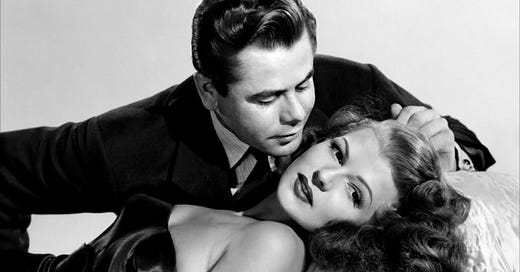A Unified Theory of Rita Hayworth’s Femmes: On Her Performance in 'Gilda'
Introducing a new series of essays on the legendary Rita Hayworth.
I often think of Laura’s portrait.
Laura Palmer and Laura Hunt’s, to be specific. The former, played by Sheryl Lee from David Lynch’s Twin Peaks (1990-91), and the latter, played by Gene Tierney, in Otto Peminger’s Laura (1944).
Both women function within their respective narratives as femmes fatale, and their portraits — Palmer’s a class photo and Hunt’s an oil painting — are simultaneous vessels and doorways. Within their images, they carry ideas of what a woman ought to be: beautiful, welcoming, delicate, and, most importantly, silent. Soft and smiling eyes, unwavering in their watchfulness and attentiveness, leave them open to their viewer’s imagination and desires, mostly to the clutches of their male character counterparts, who observe their images in order to wield and manipulate their stories.
We see images of the two Lauras before we see them in all their contradictory complexity as humans, as flesh and blood. We see these images under the presumption that the women they depict are dead. We see Laura Palmer’s bloodless and blue dead face before we see her portrait; but as both corpse and portrait, she is unmoving and lacking the intelligent glint and glimmer of thought and psyche within her eyes. So much is said and done for and about and around Laura. In Laura, too, we are introduced to the idea of a dead Laura before we see her portrait, and before we meet her in her dimensionality in flashback first and then embodied in the present day later. Both Lauras are concepts more than people: ideas played with, manipulated and judged in men’s minds before they stand live and judgemental before for us, the viewers.
Both Lauras are inspired by Dosteovsky’s Nastasya Filippovna, literature’s most notorious femme fatale, who, in The Idiot, appears as a portrait before she does as a person. Nastasya resembles the two Lauras in the sense that she and her portrait have an orbit of men crafting and conjecturing their own one-dimensional understandings of her, quite apart from her physical lived reality. Armed with their romanticized ideas of Nastasya, they vie for control of her life and future.
The real Nastasya — a cruel, wrathful, and insane woman — treads a path that serves as the urtext for many of the twentieth century’s femmes fatale. And though she can most obviously be linked in lineage to Laura Palmer and Laura Hunt, I would argue that her soul is carried most deftly and consistently by Rita Hayworth, first and foremost in 1946’s Gilda.
A woman like Nastasya is the kind of woman Hayworth excelled at playing in Gilda and in a few subsequent films, which capture her best performances. The Hayworth femme is a woman like Nastasya, a woman keenly aware of her doom, her eventual and inevitable downfall, and who, armed with this knowledge, chooses a compelling and interesting path: not to fight it (which would be a bit boring, too expected), but to resign herself to her doom with a kind of masochistic madness. Hayworth's most masterfully portrayed femmes are deeply intelligent women who, like Nastasya, seem to function within their narratives with a keen and almost clairvoyant belief that they won’t survive their stories; accordingly, if everything is doomed, then a kind of fatalistic madness is permitted them, they believe.
Gilda’s Abandonment
In Charles Vidor’s noir Gilda, we hear Rita Hayworth’s Gilda before we see her, humming the chorus to “Put the Blame on Mame.”
Keep reading with a 7-day free trial
Subscribe to Film Daze to keep reading this post and get 7 days of free access to the full post archives.





